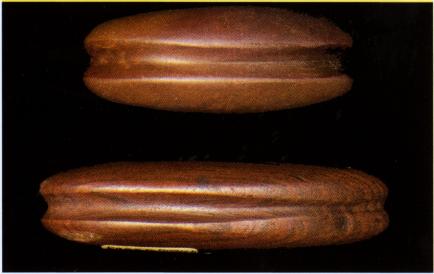Originally Published in the Central States Archaeological Journal, Vol.57, No.2, pg.60

The Archaic Period is archaeologically defined as the period from 10000 BP to 3000BP. This time span is really beyond our comprehension. Thomas Jefferson was President 200 years ago, which seems like a long time ago. The Archaic Period is 35 times 200, a mindboggling 7000 years!
In 1932, archaeologist William A. Ritchie first used the term “Archaic” in American archeological literature. He was working at the Lamoka Lake Site in New York. Subsequently, any site resembling the tool assemblage at that site was described as being “Archaic”. Today, through carbon dating and other techniques, this period separates the Paleo from the Woodland.
Originally the Archaic Period was seen as a period of roaming “hunter—gatherers” who camped year after year at sites abundant in natural resources. However, it has been discovered that during this time, mound centers were developed. The earliest is the Watsons Brake Site, which has now been dated to 5400 BP. In order to construct such a site, civilization had to develop. Organization, planning and leadership all had to come together. This is quite remarkable, as it is nearly 1000 years earlier than the construction of the Great Pyramid in Egypt. It stands to reason that Watson Brake was probably not an anomaly, and other sites from the same period exist; they just haven’t been uncovered yet. It’s probable that the nearly 1900 years until the next large known Mound Site, Poverty Point, was not devoid of civilization. Poverty Point wasn’t even discovered until the 1950’s, when someone noticed a collection of ridges on a 20 year old aerial survey map. It is a remarkable human endeavor. The mounds are the result of moving nearly one million cubic meters of earth. It is the largest prehistoric earthen-construction on the planet.
The Archaic peoples utilized knapped tools, points and knives. They also became wondrous workers of stone. This is best evidenced in their unique creation of “bannerstones”. These oddly shaped drilled artifacts appear around 8000 BP and remain in use for 5000 years until the dawn of the Woodland era. There are many thoughts on how they were utilized, the majority leaning towards being weights on the spear throwing device known as the Atlatl. Many are delicate creations, made from exotic stones. Some resemble butterflies, some are tubular while others are long and square. They are a mystery that still remains to be solved.
At the dawn of the Archaic, it’s obvious that traditions begun in Paleo times still have meaning. Some of the earliest Archaic points still exhibit flutes. At the end, there is a cultural transformation that seems to show defined religious concepts, purposeful tools and a planned social society.
As we all know, the modern United States has put an asphalt stamp on the past. Every day, more sites disappear and the fog covering the past grows thicker. Hopefully, some out-of-the-way places such as Watson Brake may escape this modern onslaught and allow us to look back and understand. The truth lies in the dirt below our feet, where once Archaic man walked, thought, hunted and gathered, living out a life, just like we do.

The Archaic Period produced all sorts of oddities, their usage only to be guessed at. Pictured at the left are two grooved artifacts commonly known as “loafstones.” They were named for their resemblance to a loaf of bread. These are made of a brownish claystone, which resembles wood in appearance. There is some thought that they might be a form of atlatl weight that would have been tied-on. Both are well made and have a high polish. The bottom artifact is 3 3/4 inches in length.
Animals furnished much more than meat for the Archaic people. They crafted skins into clothing or covers for shelters; they shaped bones into tools. Sinew became sturdy string and stomachs became useful for carrying pouches. Over time, as need presented, Archaic people developed new stone tools such as nutting stones or slabs and a variety of spear point styles as mentioned above and illustrated in the accompanying photos.
The Archaic period in the Carolinas terminated around 1000 BC. The Carolina Woodland period then began with the advent of ceramic pottery and a change of life style that became more sedentary. The Woodland period will be detailed in the next issue of Central States Journal.”Used by Permission of the Author”
To learn more about or to join the Central States Archaeological Society, click here:CSASI.org
